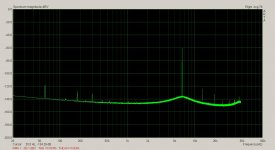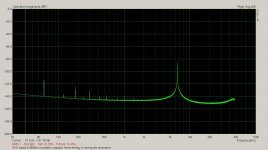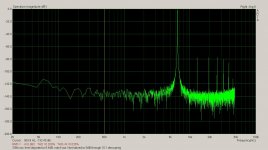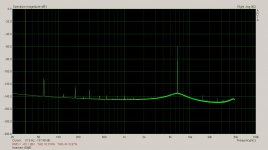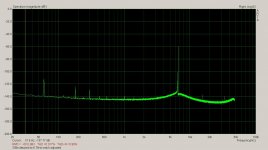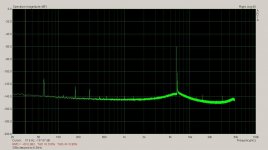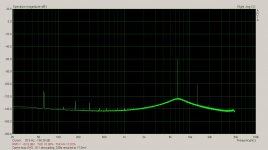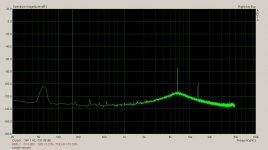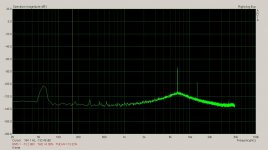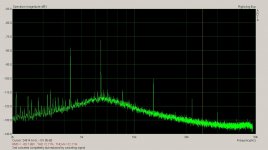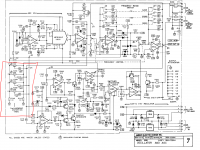I've got the 339a osc running again. here is a little experiment.
The agc of the SVO is disconnected and replace with a 9V battery and pot to control the Vc of the multiplier. A 10:1 decoupling is used to inject the 339a into the inverting node of the summing amplifier of the SVO. The Vc of the multiplier is adjusted just until oscillation stops and only the noise of the system is driving the resonance of the SVO. The 339a is connedted and tuned to the resonant frequency of the SVO as closely as posible. The ouput level of the 339a is increased to normalize a 1Vrms output from the SVO. A -60dB notch is applied.
Here are the results. The first pic is the 339a at 1Vrms.
The rest are labeled.
I'll repeat this with the SVO open looped.
The agc of the SVO is disconnected and replace with a 9V battery and pot to control the Vc of the multiplier. A 10:1 decoupling is used to inject the 339a into the inverting node of the summing amplifier of the SVO. The Vc of the multiplier is adjusted just until oscillation stops and only the noise of the system is driving the resonance of the SVO. The 339a is connedted and tuned to the resonant frequency of the SVO as closely as posible. The ouput level of the 339a is increased to normalize a 1Vrms output from the SVO. A -60dB notch is applied.
Here are the results. The first pic is the 339a at 1Vrms.
The rest are labeled.
I'll repeat this with the SVO open looped.
Attachments
Last edited:
What would you do to make a dual opamp for lower thd but not be a royal pain with stability or startup issues?? Got a circuit we can try along these lines?
Thx-RNMarsh
Read Bernie Oliver's article it is the very basis of these oscillators, if you tweak the gain control element down to its minimal effect the settling suffers i.e. as distortion goes to 0 settling time goes to infinity. There is nothing to do in the op-amp to change this (except make it the primary distortion source so it determines the settling time, which was Bernie's problem).
To put it another way it is not possible to make a distortionless oscillator, it would take forever to determine that.
Last edited:
Its ok to Not be distortionless or Blameless  Just get the thd further reduced and the noise down to best that is possible and stay within about 30 seconds settling time. At say, 100hz... lower if possible. Distortion cancellation schemes could help further without impacting stability, settling times et al.
Just get the thd further reduced and the noise down to best that is possible and stay within about 30 seconds settling time. At say, 100hz... lower if possible. Distortion cancellation schemes could help further without impacting stability, settling times et al.
-RNM
Thx-RNMarsh
-RNM
Thx-RNMarsh
With all else the same. SVO is open looped. 339a tuned to resonance of SVO and 339a level reduced to 17.5 mVrms. SVO set to 1Vrms out.
1. Can you inject a small but equal amount of 2h or 3h into fundemental freq to subtract the 2h for fundamntal. prelim tests I've done says yes it will work to cancl harmonic. But depends on circuitry being used to interface with. What can you try with what you have in this regard?
2. I have a couple commercial osc that I have adapted to using the ad797 for the osc. I will try Samuel's circuit with it by adding in the second 797.
-RNm
Last edited:
can you inject a small but eual amount of 2h or 3h into fundemental freq to subtract the 2h for fundamntal. prelim tests I've done says yes it will work to cancl harmonic. But depends on circuitry being used to interface with. What can you try with what you have in this regard?
-RNm
The 339a is source here and is the only other ultra low distortion osc I have.The only other osc I have is about 0.05% THD at 1kHz. I can try it with this.
We can cancel distortion but how do we control the phase between the two sources? How can we guarantee the correct phase relationship.
Last edited:
Read Bernie Oliver's article it is the very basis of these oscillators, if you tweak the gain control element down to its minimal effect the settling suffers i.e. as distortion goes to 0 settling time goes to infinity. There is nothing to do in the op-amp to change this (except make it the primary distortion source so it determines the settling time, which was Bernie's problem).
To put it another way it is not possible to make a distortionless oscillator, it would take forever to determine that.
What kind of oscillator was Bernie working with?
The canceling signal is injected through a separate resistor into the SVO inverting summing node.
I can add to the distortion quite easly and most cases this is what happened.
I reversed the polarity of the canceling signal and am able to completely cancel the 2nd.
However the canceled signal is replace by the canceling signal.
Canceling a distortion is like tuning a notch filter manually. It's miss most of the time.
It more likely a second source of distortion will add to the distortion unless the second distortion, (canceling distortion), is supplied by the source.
Edit: I did try canceling from the fundamental as well.
I can add to the distortion quite easly and most cases this is what happened.
I reversed the polarity of the canceling signal and am able to completely cancel the 2nd.
However the canceled signal is replace by the canceling signal.
Canceling a distortion is like tuning a notch filter manually. It's miss most of the time.
It more likely a second source of distortion will add to the distortion unless the second distortion, (canceling distortion), is supplied by the source.
Edit: I did try canceling from the fundamental as well.
Attachments
Last edited:
The 339a is source here and is the only other ultra low distortion osc I have.The only other osc I have is about 0.05% THD at 1kHz. I can try it with this.
We can cancel distortion but how do we control the phase between the two sources? How can we guarantee the correct phase relationship.
Just a proof of concept.... wont get complete cancel... but some average cancel and with enough amplitude, pretty good cancel amount.
later for synch'ing... just see if you can get any reduction for now. next try to get 2h synch'ed off the fundemental with a freq doubler. AD633?
-RNM
Last edited:
Was the 339 a Barney Oliver project? He would have been CTO or some such when it was being designed I believe.
I wonder if this theory is more to do with lamp stabilization or passive stabilizing elements (thermistors). Is distortion necessary for stabilizing in the case of a fast AGC system. The additional energy provided by the distortion is not needed.
Just a proof of concept.... wont get complete cancel... but some average cancel and with enough amplitude, pretty good cancel amount.
later for synch'ing... just see if you can get any reduction for now. next try to get 2h synch'ed off the fundemental with a freq doubler. AD633?
-RNM
I have some AD633 but it would be a major set up right now. Maybe later.
If you could brick wall the fundamental and preserve the phase of the harmonics you might be able cancel the entire works of harmonics. But this is a lot of fuss.
Everyone should help to brain storm various ways to do the cancel. There may be less fuss to do it after thinking on it some more.
You certainly do not have to have superlow thd if you can just subtract harmonics vis this 2h injection of a few milli-volts of 2h at the right point. [of course this applies to other harmonics as well..... but starting with 2h and 3h as they dominate the thd].
Thx-RNMarsh
Last edited:
I wonder if this theory is more to do with lamp stabilization or passive stabilizing elements (thermistors). Is distortion necessary for stabilizing in the case of a fast AGC system. The additional energy provided by the distortion is not needed.
Check !


Was the 339 a Barney Oliver project? He would have been CTO or some such when it was being designed I believe.
No, he wrote an HP technote when oscillators with too little distortion in the amplifier would not settle down. He produced an unusually sophisticated mathematical analysis of the circuit.
This is probably not the most intuitive problem. The circuit has a complex pair that sits on the imaginary axis at oscillation, one little iota to one side and the amplitude blows up the other way it goes to zero. The amplitude control loop in stasis walks the poles back and forth over the axis (i.e. distortion, thirds). When tweaked to the max this walk is reduced to a very small amount but the speed of the walk gets very slow (never settles in the limit). It can be shown that the distortion alone (compressive limiting) will stabilize the system without the gain control loop, or you could say it is the gain control loop.
Last edited:
I posted this once before. The part circled in red is a second harmonic cancellation circuit in the Amber 3500 SVO. I see no reason why it couldn't be implemented in other SVO's. It feeds from two phases in just the right amount to cancel 2nd harmonics. I don't have a suitable platform to try it right now.
Attachments
I posted this once before. The part circled in red is a second harmonic cancellation circuit in the Amber 3500 SVO. I see no reason why it couldn't be implemented in other SVO's. It feeds from two phases in just the right amount to cancel 2nd harmonics. I don't have a suitable platform to try it right now.
Seconds are secondary it's the thirds that are inherent in the gain contol process. This still might be useful.
Also, Hickman did 3rd cancellation by mixing outputs LP + HP/9 (Analog circuits cookbook, Hickman 1999)
The APF in post #1 does it too (yeah, that thing again) It can be gain tuned for a different harmonic.
The downside is it can increase other harmonics and increase noise, but it's good if you have a single very dominant harmonic.
edtit: and it can mess with your output levels
The APF in post #1 does it too (yeah, that thing again) It can be gain tuned for a different harmonic.
The downside is it can increase other harmonics and increase noise, but it's good if you have a single very dominant harmonic.
edtit: and it can mess with your output levels
Last edited:
- Home
- Design & Build
- Equipment & Tools
- Low-distortion Audio-range Oscillator
